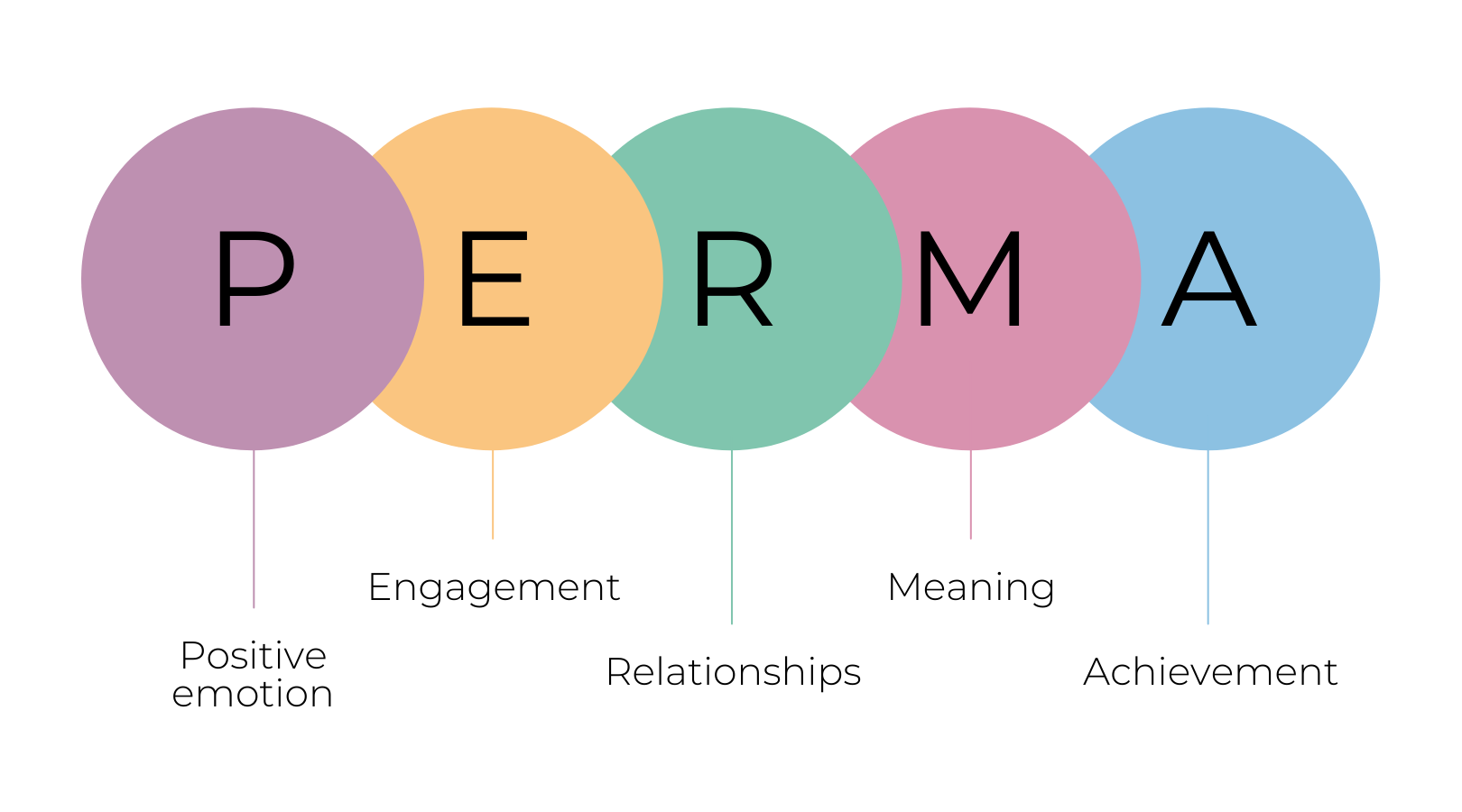Why do we need a model of well-being and why is this one good?
Well-being is a central idea in positive psychology. If positive psychology is defined as the study of ‘what goes right in life’ or of people ‘flourishing’ or achieving levels of ‘optimal functioning’ (sounds slightly robotic that last one, but you get what I mean), then you can see why well-being is really important in the field. But since the birth of modern positive psychology, many researchers, social scientists, practitioners and even governments have become interested in the idea.
Why? Well on the one hand, because well-being matters to each and every human-being and in some way, most of us are striving for it. And on another hand, because well-being is related to economic health: at an individual level, if we’re experiencing higher well-being, we’re likely to be more productive and make a greater contribution to society. And because of that, at a national societal level, health outcomes improve and countries’ economies grow.
There are several solid, well-researched models of well-being out there and more are being developed all the time, so why is the positive psychology PERMA model worth particular attention? Mainly because it’s well-researched and that’s because it was developed by well-respected psychologist Professor Martin Seligman and first appeared in his 2011 book, ‘Flourish’. Today, I want to take you through the PERMA model, explain each element, and give you a sense of practically-speaking, how you can use it to up your own well-being.
The PERMA model in summary
Seligman describes PERMA as a five factor model, which others have added to over the years but today I’m just going to cover the fab five of:

-
The role of positive emotions
When Seligman included positive emotions his model, there were always going to be knockers. These days, there are people who talk about toxic positivity, a lot. These people genuinely have a point, because when we suppress negative emotions, perhaps trying to force them out with positive emotions, that can actually store up future mental and physical health issues. All emotions are welcome, right? And we need to work on how best to handle them.
However, it is definitely true, the evidence tells us so, that experiencing more positive emotions in general can have major benefits in a variety of areas. And because humans are super-vigilant around negative stimuli, we have to work harder to cultivate and nurture, even to access positive emotions over negative ones. So I feel a touch of regret that (rightly) bigging up the importance of dealing with negative emotions in a healthy way, some commentators have unwittingly given bad press to the important role of positive emotions in our well-being.
When we experience positive emotions, like optimism or hope or trust, pride, awe or satisfaction, this opens up various centres of the brain that are less accessible or even inaccessible when we are experiencing negative emotions. Negative emotions tend to lead to a narrowing of our thinking and to a diversion of our brain centres towards dealing with the perceived threat. But positive emotions do the opposite and with that, our brain becomes more open to learning, more open to experience and is able to grow and develop much more easily. In short, it’s much easier to experience the world at its fullest, and to truly appreciate and be grateful for it, when our brains are in a positive emotional state.
How to do it: Two key ideas here: Firstly, developing a gratitude practice, which I go into much more detail on in my podcast at Season 9, episode 9: The benefits of gratitude – giving thanks to 2020; and secondly, taking the time to reflect on positive experiences and feelings you have had, so that you can recall how those experiences looked, felt, smelled and tasted. Generally, we tend to reflect back A LOT on things that didn’t go so well but we don’t do that as a rule with positive experiences in anything like as much depth or detail. I have more on this in my podcast at Season 3, episode 6: How to stay positive.
-
Engagement and flow
Mihaly Csikszentmihalyi first described the idea of flow in the 1970s and then interest in it grew in the 80s and it has sat proudly as a core concept of positive psychology ever since. Flow includes the loss of self-consciousness and complete absorption in an activity. In other words, it is living in the present moment and focusing entirely on whatever it is you’re doing.
So how do you achieve a state of flow (and with it, complete engagement in what you are doing)? Well flow is most likely to happen when you are challenged by a task but you have the skill you need to deliver a good result with that task. When your skill level is too high, it can lead to disengagement through boredom. When your skill level is too low, it can lead to disengagement through stress and self-protection.
In separate research, Seligman and his colleagues found that people are more likely to experience flow when they use their top strengths. Research they did on the use of strengths to achieve flow found that individuals who try to use their strengths in new ways each day for a week were happier and less depressed after six months.
How to do it: Get yourself a strength assessment and then consider how you can do two things: 1. Use your strengths more of the time to get enjoyment from what you’re doing. And a longer term 2. Craft your role and career around your strengths, because that way, you’ll be more likely to stay more engaged more of the time in the work you do. My back catalogue is rammed full of tips on how to do this, so just pick a title and see what you can find. Most of the podcasts are around 10 minutes long, so it’s not a huge time investment.
-
Why relationships matter
So here I’m talking about all the relationships you have in your life – at work and at home – friends, family, colleagues, acquaintances, everyone. Some research relates us having strong relationships with people who value to reduced chances of inflammation (as we know, the basis of all diseases). We also know that positive neurotransmitters and hormones like oxytocin kick in when we feel connected, and these hormones can reduce stress levels, which in turn improves immune system function, and that can reduce the chances of you getting ill. You’re also less likely to engage in unhealthy behaviours with a stronger social network, so logically then, you’re less likely to get ill or die. Yet more research shows that having a strong social network prevents cognitive decline in older adults.
How to do it: Keep in touch with the people that matter to you – be proactive in that, don’t wait, reach out. And do a relationship audit on the people who you find bring energy and positive emotions to you and spend more time with them rather than those who drain your energy. For more on this, listen to my podcast at Season 8, episode 4: Building out your support network
-
Meaning, purpose and direction
This is a really interesting area because it is so so unique to each and every human. Some people talk about dedicating themselves to something greater than themselves as providing them with a sense of meaning. For others, having a general direction towards personal growth or greater job satisfaction is more than enough.
To find your meaning, your purpose, your direction, a great place to start is to reflect on your personal values as a sense of meaning is often informed by your values. Make sure that you’re living your life in alignment with your values and also asking yourself how you might be able to do more with your values.
How to do it: The general view is that to create greater meaning in your life, do something that gives you a sense of purpose beyond the day to day, e.g. getting more involved in a cause or organisation that matters to you. And you could also give a listen to my podcast as Season 10, episode 11: How to find your purpose and why you don’t have to.
-
Accomplishments – how to gain mastery and why it matters
The last letter of the PERMA model stands for Achievements or Accomplishments. That is, reaching goals or accomplishing things that matter to you. Doing this ups your well-being by building your sense of confidence and self-efficacy that you are able to achieve what you set out to, as well as by encouraging a sense of pride in your achievements. Interestingly, according to Seligman’s research, achieving intrinsic goals (like those relating to personal growth) leads to larger gains in well-being than extrinsic goals such as money or fame.
How to do it:
first up – use your strengths. Drawing on your strengths to overcome a challenge or attain a goal can create a sense of ‘can do’ because you are making a conscious choice about how you can bring the best of yourself to a situation or goal. Secondly, adopt a growth mindset, seeing setbacks and failure as primarily an opportunity to learn rather than as a crushing defeat. For more on that, check out my podcast at Season 9, episode 11 – what is growth mindset and how to develop one. Finally, SMART goals are always a good way of maxing your chances of success when striving for a goal – make your goal specific, measurable, achievable, relevant and time-limited.
Conclusion – PERMA is for life but you can start right now
So there you have the PERMA model: positive emotions, engagement and flow, relationships, meaning and purpose and achievements and accomplishments. Looking for opportunities to tweak and upgrade in any area, or even all areas, is pretty much guaranteed to notch up your sense of well-being, so take some time to reflect and then act. Take action on the one thing that you feel will be of greatest benefit to your well-being right now. And keep coming back to it, every little action nudges your well-being in a positive direction.
For even more on well-being, check out some of my other podcasts:
- Season 8, Episode 12: Supercharge your well-being
- Season 9, episodes 1-2: Improving your career well-being parts 1 and 2.
Till next time, stay strong.











